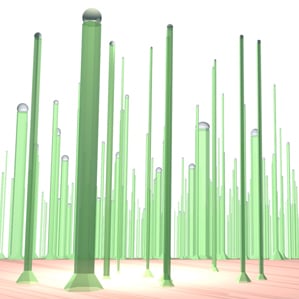Nanowires Suck Up Light from Around Them
The unusual optical properties of nanowires could lead to cheaper, more efficient solar panels, new research suggests.

Researchers in Denmark and Switzerland have built solar cells from individual nanowires, and showed that the nanowires absorbed far more light than expected based on their size. The solar cells behaved as if they were gathering light from an area eight times larger than their physical size, the researchers write in the current issue of Nature Photonics. This property could lead to solar cells that use less material than conventional ones, yet convert more of the energy in sunlight into electricity, reducing the cost of solar power.
The fact that nanowires can pull in light from around them “opens up the possibility for large-scale photovoltaics using only a fraction of the material,” says Magnus Borgstrom, professor of solid state physics at Lund University in Sweden, who was not involved in the work.
The effect demonstrated in the paper is equivalent to using a lens or a mirror to concentrate light, an approach that’s been used to reduce the size and cost of solar cells as well as improve their efficiency. The new study suggests nanowires can provide the same benefits without the need for mirrors or lenses, lowering costs. “We show that nanowires incorporate the concentration intrinsically,” says Anna Fontcuberta i Morral, a professor at Ecole Polytechnique Federale de Lausanne who led the work.
Researchers have known that nanostructures can interact with light in unusual ways if they’re narrower than the wavelengths of light (see “Sunlight Absorber” and “Solar Cells Use Nanoparticles to Capture More Sunlight”). The concentration effect has been suggested before—for example, a paper published in the journal Science earlier this month attributes record efficiencies in a nanowire-based solar cell to the effect. But the new paper provides a way to quantify the concentration effect by measuring the performance of a single nanowire solar cell.
Nanowire solar cells have been under development for years—but not because of their ability to concentrate light. Researchers originally proposed that arrays of nanowires would be good at trapping more light, because as light penetrates the array, it would bounce around from one nanowire to another until it’s been absorbed, like light entering a dense forest. Such arrays could use less of the expensive semiconductor materials used in solar cells (see “How to Double the Power of Solar Panels”).
The new findings suggest that it could be possible to use fewer nanowires while still capturing the same amount of light as previously proposed nanowire solar cells, further reducing the amount of material needed, Morral says. She used gallium arsenide for her nanowires, the material used in the world’s most efficient solar cells. She says that solar cells made from arrays of gallium arsenide nanowires could use a tenth as much material as existing gallium arsenide cells. And, at least in theory, they could be more efficient.
The paper, however, doesn’t address some key issues with making efficient nanowire solar cells. For example, the large surface area of arrays of nanowires provides a lot of places for electrons to be trapped, reducing the practical efficiency of such devices. The best efficiency for a nanowire solar cell so far is only 13.8 percent efficient, far lower than the 20 percent possible with conventional solar cells and the 28.8 percent achieved by the world-record gallium arsenide cells. Addressing those problems will require improving methods for forming nanowires and chemically treating their surfaces.
Keep Reading
Most Popular
Large language models can do jaw-dropping things. But nobody knows exactly why.
And that's a problem. Figuring it out is one of the biggest scientific puzzles of our time and a crucial step towards controlling more powerful future models.
How scientists traced a mysterious covid case back to six toilets
When wastewater surveillance turns into a hunt for a single infected individual, the ethics get tricky.
The problem with plug-in hybrids? Their drivers.
Plug-in hybrids are often sold as a transition to EVs, but new data from Europe shows we’re still underestimating the emissions they produce.
Google DeepMind’s new generative model makes Super Mario–like games from scratch
Genie learns how to control games by watching hours and hours of video. It could help train next-gen robots too.
Stay connected
Get the latest updates from
MIT Technology Review
Discover special offers, top stories, upcoming events, and more.